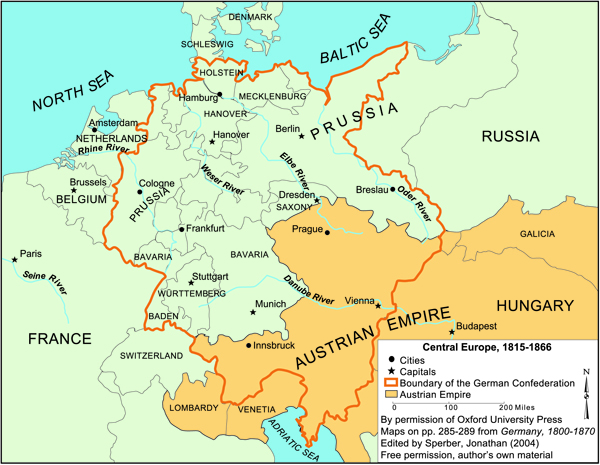













INTRODUCTION | DOCUMENTS | IMAGES | MAPS | EDITOR
|
The two dominant powers were Prussia and Austria. Only a portion of their respective territories belonged to the Confederation. Prussia had received part of Saxony at the Congress of Vienna as well as sizable territories in the Rhineland and Westphalia, and with these additions its expanse had moved westward. Austria had lost the Habsburg Netherlands (Belgium), but gained territories in Italy, on the Adriatic Sea and in eastern Europe. The kings of Great Britain, Denmark, and the Netherlands also belonged to the Confederation, since they governed the Kingdom of Hanover (until 1837), the Duchy of Holstein, and the Grand Duchy of Luxemburg, respectively, in a personal union. Additionally, the Confederation included the kingdoms of Bavaria, Württemberg, and Saxony, the Electorate of Hesse, the Grand Duchies of Baden, Hesse-Darmstadt, Mecklenburg-Schwerin, Mecklenburg-Strelitz, Oldenburg, and Saxony-Weimar, as well as various smaller duchies and princedoms primarily in central Germany. Lübeck, Hamburg, Bremen, and Frankfurt am Main remained free cities and participated in the Confederation as such. In the years after 1815, during the Vormärz period, it became clear that the German Confederation did not view itself as a precursor to a German national state. Under the influence of the conservative Austrian chancellor Clemens von Metternich, it acted more as a bulwark against demands for national unity and democratic participation by decreeing constitutions, and it also insisted firmly on the monarchical principle. The German Confederation survived the revolutions of 1848/49 and was formally restored in 1850. A few years later, it fell apart due to the increasingly stark contrast between Prussia and Austria. The Confederation was dissolved after the Austro-Prussian War of 1866. The war was an important step on the path to a “small German” solution of the national question – i.e., without Austria – and the creation of the German Reich in 1871. Please click on print version (below) for a larger version with enhanced resolution.
By permission of Oxford University Press, www.oup.com. |
 print version
print version return to map list
return to map list previous map
previous map
